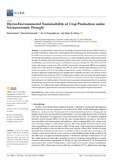Hydro-environmental sustainability of crop production under socioeconomic drought
Fecha
2023Versión
Acceso abierto / Sarbide irekia
Tipo
Artículo / Artikulua
Versión
Versión publicada / Argitaratu den bertsioa
Impacto
|
|
10.3390/w15020288
Resumen
A comprehensive framework for revealing the jeopardization between SDGs 2 and 6 is provided in this study. Along with a water footprint (WF) assessment, the 30-years pattern of agricultural WFs and its hydro-environmental, social, and ecopolitical (SEP) consequences were quantified for the major food producer regions of Iran, as it is a water-bankrupted country under socioeconomic drought. In add ...
[++]
A comprehensive framework for revealing the jeopardization between SDGs 2 and 6 is provided in this study. Along with a water footprint (WF) assessment, the 30-years pattern of agricultural WFs and its hydro-environmental, social, and ecopolitical (SEP) consequences were quantified for the major food producer regions of Iran, as it is a water-bankrupted country under socioeconomic drought. In addition, the enforced impacts of major water/food-related policies on environmental sustainability were analyzed through an institutional assessment. During 1986–2016, BWS and GWD raised with annual average rates of 5% and 44%, respectively. Consequently, SEP status prospered along with an 18% increase in irrigated area, 198% in added-value by crop production and 5% by staple-crop exports, and 51% in the number of agricultural workers. The Pearson correlation analysis revealed a significant tradeoff between self-supplied food availability and SEP. A 54% increase in food production occurred at the cost of 80% overexploitation in blue water resources and quality degradation. An annual average increase of 1.1% in P/ETo indicates the dominant role of anthropogenic interventions in such deteriorations. The institutional assessment demonstrated that environmental sustainability policies have never been applied as promoting policies to boost self-sufficiency in food production. According to the results, hydrological sustainability requires a transformative vision in national policies to exploit limited water and soil resources while preserving the environment. [--]
Materias
Blue water scarcity,
Cash-scarce community,
Environmental deteriorations,
Food insecurity,
Hydrological sustainability,
Intensive agriculture
Editor
MDPI
Publicado en
Water 2023, 15(2), 288
Departamento
Universidad Pública de Navarra/Nafarroako Unibertsitate Publikoa. Institute on Innovation and Sustainable Development in Food Chain - ISFOOD






